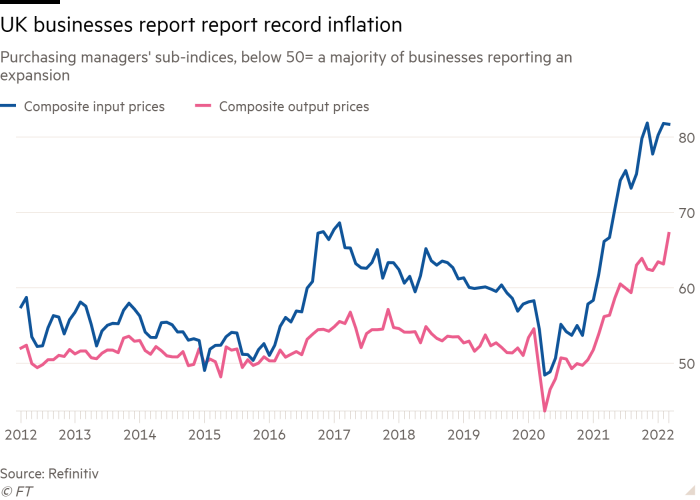UK business activity slowed less than expected in March but waning optimism in the manufacturing and services sector combined with surging inflation pointed to the prospect of “stagflation” in the months ahead, according to a closely watched survey.
The S&P flash UK purchasing manager composite index, a measure of the health of the services and manufacturing sectors, fell to a two-month low of 59.7 in March from 59.9 in February.
However, the figure still surpassed the 57.8 forecast by economists polled by Reuters and was well above the 50 mark indicating that a majority of businesses had reported growth.
Chris Williamson, chief business economist at S&P Global, said the survey indicated a sustained, robust pace of expansion as economic activity following the end of Covid-19 restrictions helped to offset headwinds from the Ukraine war, Brexit and rising prices.
But he also warned of “potentially sharply slower growth in the coming months, accompanied by a further acceleration of inflation and a worsening cost of living crisis, which paints an unwelcome picture of ‘stagflation’ for the economy in the months ahead”.

Stagflation refers to uncommon periods of slow growth combined with high inflation.
On Wednesday, the Office for Budget Responsibility, the fiscal watchdog, downgraded the UK growth outlook this year to 3.8 per cent from 6 per cent forecast in October after real household income dropped to its lowest level since records began in 1957.
The PMI survey showed that escalating inflationary pressures and concerns over Russia’s invasion of Ukraine led to a slump in business optimism, which this month dropped to a 17-month low.
Moreover, surging fuel, energy and staff costs resulted in businesses charging their steepest prices since the index began in November 1999.
The PMI reading, based on data gathered between March 12 and 22, showed that the average cost burden rose sharply in March, signalling the second-fastest rate of inflation for more than two decades.
Growth was stronger than expected in the services sector, boosted by the removal of Covid-19 restrictions and people returning to offices, alongside the release of pent-up demand for travel, leisure and entertainment.
However, this was offset by a slowdown in manufacturing output, which fell to a five-month low as a result of supply shortages and escalating inflationary pressures dampening demand.
Growth in new manufacturing orders dropped to their lowest level since lockdown was reinstated in January 2021, dragged down by weaker domestic demand.
Gabriella Dickens, economist at Pantheon Macroeconomics, said that the PMIs were consistent with UK gross domestic product rising 1 per cent in the first quarter.
But, she added: “With Covid-related health spending set to be wound down and the squeeze on real incomes about to intensify in April, GDP probably will fall by about 0.2 per cent in Q2.”
In the eurozone, activity slowed to a two-month low as the economic impact of Russia’s invasion of Ukraine offset a boost in consumer demand following the lifting of Covid restrictions.
UK business survey points to ‘stagflation’
Pinoy Variant